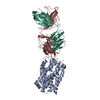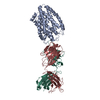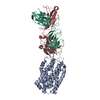+ Open data
Open data
- Basic information
Basic information
| Entry | Database: PDB / ID: 7vad | |||||||||
|---|---|---|---|---|---|---|---|---|---|---|
| Title | Cryo-EM structure of human NTCP complexed with YN69202Fab | |||||||||
 Components Components |
| |||||||||
 Keywords Keywords |  TRANSPORT PROTEIN / Hepatitis B virus (HBV) / host entry receptor / bile acid transporter / TRANSPORT PROTEIN / Hepatitis B virus (HBV) / host entry receptor / bile acid transporter /  taurocholate / Na+-coupled symporter taurocholate / Na+-coupled symporter | |||||||||
| Function / homology |  Function and homology information Function and homology information bile acid:sodium symporter activity / regulation of bile acid secretion / bile acid and bile salt transport / bile acid signaling pathway / Recycling of bile acids and salts / response to nutrient levels / response to organic cyclic compound / response to estrogen / cellular response to xenobiotic stimulus / virus receptor activity ... bile acid:sodium symporter activity / regulation of bile acid secretion / bile acid and bile salt transport / bile acid signaling pathway / Recycling of bile acids and salts / response to nutrient levels / response to organic cyclic compound / response to estrogen / cellular response to xenobiotic stimulus / virus receptor activity ... bile acid:sodium symporter activity / regulation of bile acid secretion / bile acid and bile salt transport / bile acid signaling pathway / Recycling of bile acids and salts / response to nutrient levels / response to organic cyclic compound / response to estrogen / cellular response to xenobiotic stimulus / virus receptor activity / basolateral plasma membrane / response to ethanol / bile acid:sodium symporter activity / regulation of bile acid secretion / bile acid and bile salt transport / bile acid signaling pathway / Recycling of bile acids and salts / response to nutrient levels / response to organic cyclic compound / response to estrogen / cellular response to xenobiotic stimulus / virus receptor activity / basolateral plasma membrane / response to ethanol /  plasma membrane plasma membraneSimilarity search - Function | |||||||||
| Biological species |   Homo sapiens (human) Homo sapiens (human)  Mus musculus (house mouse) Mus musculus (house mouse) | |||||||||
| Method |  ELECTRON MICROSCOPY / ELECTRON MICROSCOPY /  single particle reconstruction / single particle reconstruction /  cryo EM / Resolution: 3.41 Å cryo EM / Resolution: 3.41 Å | |||||||||
 Authors Authors | Asami, J. / Shimizu, T. / Ohto, U. | |||||||||
| Funding support |  Japan, 2items Japan, 2items
| |||||||||
 Citation Citation |  Journal: Nature / Year: 2022 Journal: Nature / Year: 2022Title: Structure of the bile acid transporter and HBV receptor NTCP. Authors: Jinta Asami / Kanako Terakado Kimura / Yoko Fujita-Fujiharu / Hanako Ishida / Zhikuan Zhang / Yayoi Nomura / Kehong Liu / Tomoko Uemura / Yumi Sato / Masatsugu Ono / Masaki Yamamoto / ...Authors: Jinta Asami / Kanako Terakado Kimura / Yoko Fujita-Fujiharu / Hanako Ishida / Zhikuan Zhang / Yayoi Nomura / Kehong Liu / Tomoko Uemura / Yumi Sato / Masatsugu Ono / Masaki Yamamoto / Takeshi Noda / Hideki Shigematsu / David Drew / So Iwata / Toshiyuki Shimizu / Norimichi Nomura / Umeharu Ohto /   Abstract: Chronic infection with hepatitis B virus (HBV) affects more than 290 million people worldwide, is a major cause of cirrhosis and hepatocellular carcinoma, and results in an estimated 820,000 deaths ...Chronic infection with hepatitis B virus (HBV) affects more than 290 million people worldwide, is a major cause of cirrhosis and hepatocellular carcinoma, and results in an estimated 820,000 deaths annually. For HBV infection to be established, a molecular interaction is required between the large glycoproteins of the virus envelope (known as LHBs) and the host entry receptor sodium taurocholate co-transporting polypeptide (NTCP), a sodium-dependent bile acid transporter from the blood to hepatocytes. However, the molecular basis for the virus-transporter interaction is poorly understood. Here we report the cryo-electron microscopy structures of human, bovine and rat NTCPs in the apo state, which reveal the presence of a tunnel across the membrane and a possible transport route for the substrate. Moreover, the cryo-electron microscopy structure of human NTCP in the presence of the myristoylated preS1 domain of LHBs, together with mutation and transport assays, suggest a binding mode in which preS1 and the substrate compete for the extracellular opening of the tunnel in NTCP. Our preS1 domain interaction analysis enables a mechanistic interpretation of naturally occurring HBV-insusceptible mutations in human NTCP. Together, our findings provide a structural framework for HBV recognition and a mechanistic understanding of sodium-dependent bile acid translocation by mammalian NTCPs. | |||||||||
| History |
|
- Structure visualization
Structure visualization
| Structure viewer | Molecule:  Molmil Molmil Jmol/JSmol Jmol/JSmol |
|---|
- Downloads & links
Downloads & links
- Download
Download
| PDBx/mmCIF format |  7vad.cif.gz 7vad.cif.gz | 133.7 KB | Display |  PDBx/mmCIF format PDBx/mmCIF format |
|---|---|---|---|---|
| PDB format |  pdb7vad.ent.gz pdb7vad.ent.gz | 106.3 KB | Display |  PDB format PDB format |
| PDBx/mmJSON format |  7vad.json.gz 7vad.json.gz | Tree view |  PDBx/mmJSON format PDBx/mmJSON format | |
| Others |  Other downloads Other downloads |
-Validation report
| Arichive directory |  https://data.pdbj.org/pub/pdb/validation_reports/va/7vad https://data.pdbj.org/pub/pdb/validation_reports/va/7vad ftp://data.pdbj.org/pub/pdb/validation_reports/va/7vad ftp://data.pdbj.org/pub/pdb/validation_reports/va/7vad | HTTPS FTP |
|---|
-Related structure data
| Related structure data |  31837MC  7vaeC  7vafC  7vagC  7wsiC M: map data used to model this data C: citing same article ( |
|---|---|
| Similar structure data | Similarity search - Function & homology  F&H Search F&H Search |
| EM raw data |  EMPIAR-11056 (Title: Structure of bile acid transporter NTCP / Data size: 8.6 TB EMPIAR-11056 (Title: Structure of bile acid transporter NTCP / Data size: 8.6 TBData #1: Raw movies for Human NTCP (Q261A) - YN69202Fab (EMD-31837, PDB 7VAD) [micrographs - multiframe] Data #2: Raw movies for Bovine NTCP (Q261A) - YN69202Fab (EMD-31838, PDB 7VAE) [micrographs - multiframe] Data #3: Raw movies for Rat NTCP (Q261A) - YN69202Fab (EMD-31839, PDB 7VAE) [micrographs - multiframe] Data #4: Raw movies for Human NTCP (Q261A) - YN69202Fab-myr-preS1 (EMD-31840, PDB 7VAF) [micrographs - multiframe] Data #5: Raw movies for Human NTCP (wildtype) - YN69202Fab (EMD-32759, PDB 7WSI) [micrographs - multiframe]) |
- Links
Links
- Assembly
Assembly
| Deposited unit | 
|
|---|---|
| 1 |
|
- Components
Components
| #1: Protein |  / Cell growth-inhibiting gene 29 protein / Na(+)/bile acid cotransporter / Na(+)/taurocholate ...Cell growth-inhibiting gene 29 protein / Na(+)/bile acid cotransporter / Na(+)/taurocholate transport protein / Sodium/taurocholate cotransporting polypeptide / Solute carrier family 10 member 1 / Cell growth-inhibiting gene 29 protein / Na(+)/bile acid cotransporter / Na(+)/taurocholate ...Cell growth-inhibiting gene 29 protein / Na(+)/bile acid cotransporter / Na(+)/taurocholate transport protein / Sodium/taurocholate cotransporting polypeptide / Solute carrier family 10 member 1Mass: 38141.832 Da / Num. of mol.: 1 / Mutation: Q261A Source method: isolated from a genetically manipulated source Source: (gene. exp.)   Homo sapiens (human) / Gene: NTCP / Production host: Homo sapiens (human) / Gene: NTCP / Production host:   Spodoptera frugiperda (fall armyworm) / References: UniProt: Q14973 Spodoptera frugiperda (fall armyworm) / References: UniProt: Q14973 |
|---|---|
| #2: Antibody | Mass: 26574.695 Da / Num. of mol.: 1 Source method: isolated from a genetically manipulated source Source: (gene. exp.)   Mus musculus (house mouse) / Production host: Mus musculus (house mouse) / Production host:   Spodoptera frugiperda (fall armyworm) Spodoptera frugiperda (fall armyworm) |
| #3: Antibody | Mass: 24323.990 Da / Num. of mol.: 1 Source method: isolated from a genetically manipulated source Source: (gene. exp.)   Mus musculus (house mouse) / Production host: Mus musculus (house mouse) / Production host:   Spodoptera frugiperda (fall armyworm) Spodoptera frugiperda (fall armyworm) |
-Experimental details
-Experiment
| Experiment | Method:  ELECTRON MICROSCOPY ELECTRON MICROSCOPY |
|---|---|
| EM experiment | Aggregation state: PARTICLE / 3D reconstruction method:  single particle reconstruction single particle reconstruction |
- Sample preparation
Sample preparation
| Component |
| ||||||||||||||||||||||||
|---|---|---|---|---|---|---|---|---|---|---|---|---|---|---|---|---|---|---|---|---|---|---|---|---|---|
| Molecular weight | Experimental value: NO | ||||||||||||||||||||||||
| Source (natural) |
| ||||||||||||||||||||||||
| Source (recombinant) |
| ||||||||||||||||||||||||
| Buffer solution | pH: 7.5 Details: 25 mM Hepes-NaOH, pH 7.5, 0.15 M NaCl, and 0.01% GDN | ||||||||||||||||||||||||
| Specimen | Embedding applied: NO / Shadowing applied: NO / Staining applied : NO / Vitrification applied : NO / Vitrification applied : YES : YES | ||||||||||||||||||||||||
Vitrification | Cryogen name: ETHANE |
- Electron microscopy imaging
Electron microscopy imaging
| Experimental equipment |  Model: Titan Krios / Image courtesy: FEI Company |
|---|---|
| Microscopy | Model: FEI TITAN KRIOS |
| Electron gun | Electron source : :  FIELD EMISSION GUN / Accelerating voltage: 300 kV / Illumination mode: FLOOD BEAM FIELD EMISSION GUN / Accelerating voltage: 300 kV / Illumination mode: FLOOD BEAM |
| Electron lens | Mode: BRIGHT FIELD Bright-field microscopy Bright-field microscopy |
| Image recording | Electron dose: 61 e/Å2 / Film or detector model: GATAN K3 (6k x 4k) |
- Processing
Processing
CTF correction | Type: NONE |
|---|---|
3D reconstruction | Resolution: 3.41 Å / Resolution method: FSC 0.143 CUT-OFF / Num. of particles: 103174 / Symmetry type: POINT |
 Movie
Movie Controller
Controller







 PDBj
PDBj




